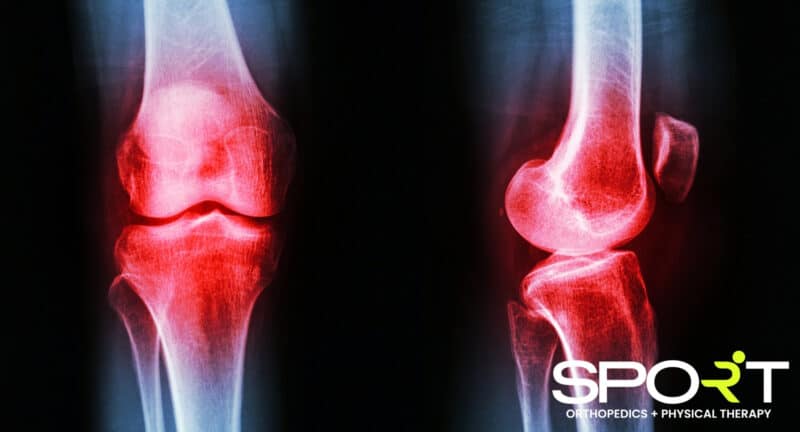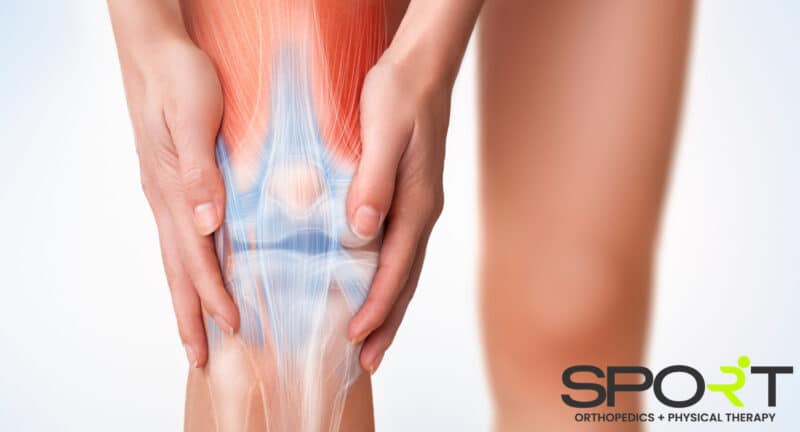Knee Instability Treatment in Dallas & Frisco
Patellar Instability Surgery, Patellar Subluxation
Knee Instability Treatment and Surgery in Dallas & Frisco, TX
Your kneecap is an integral part of your leg. It protects your knee joint from blows or other severely damaging injuries. Also known as the patella, strong ligaments keep the kneecap in place over the joint hinge and moving correctly. Sometimes the patella slips out of place or dislocates because of ligament injuries. These injuries cause the kneecap to move up and down in the trochlear groove during knee flexion. This patellar instability causes swelling, stiffness, and a sore knee.
Sometimes you may feel as though your knee will give out while moving around or just standing still. Damaged tendons or leg muscles don’t move properly, causing pain and weakness.
At SPORT Orthopedics + Physical Therapy, we have extensive experience in surgical and nonsurgical patellar instability treatments. Our talented Dallas surgeons and physical therapists evaluate your knee’s condition, devise a treatment plan, and get you on the path back to doing your normal activities. If you’re experiencing instability or pain in your knee, please call us at (469) 200-2832 and schedule an appointment today.
Causes of Knee Instability

The two types of knee instability are traumatic patellar dislocation and chronic patellar instability. Traumatic dislocation typically occurs after a knee injury, and the kneecap gets knocked out of the groove. The kneecap only moves partially out of the groove with chronic patellar instability. This is called patellar subluxation.
With an undamaged knee joint, the kneecap slides into the groove in the femur when the knee bends. This dip is called the trochlear notch. Some people have abnormalities of the trochlea, predisposing them to knee instability.
There are several other common reasons the patella doesn’t move as it should. Some of the most common causes include:
When a ligament is sprained it means direct traumatic injury, sudden stress, or simple wear and tear damaged the ligament fibers. Injuries caused by ligament sprains include ACL sprains (anterior cruciate ligament), LCL (lateral collateral ligament) sprain, (and MCL sprain (medial collateral ligament).
This ligament injury occurs when the ligament becomes fully or partially torn. It’s typically caused by sudden stops that cause the knee to remain facing one direction while the rest of the body twists the opposite way.
Common injuries associated with ligament tears include ACL tears, MCL tears, and LCL injury. To find out “What does ACL stand for?”, please read our related blog.
The knee has two cartilage pieces that work as shock absorbers. They’re called the menisci. This cartilage injury often occurs alongside another knee injury, such as a direct blow or a forceful, pivoting action.
A meniscus torn during everyday activity may occur in older people if the cartilage has thinned due to age. The knee doesn’t work properly when the meniscus is torn. It may give way, lock up, or catch.
Runner’s knee can also be referred to as patellofemoral pain syndrome (PFPS). It’s commonly caused by overuse in sports training. There is a predisposition when a prior knee injury or misaligned knee joint exists.
PFPS can affect anyone but is most common in sports enthusiasts and women. The cartilage wears away with this syndrome, causing pain when exercising.
Arthritis is common in the knee, though it may affect any joint in the body. Knee arthritis is inflammation of the knee joint. In addition to pain, the disease causes a stiff knee, knee instability, and swelling.
Severe arthritis of the knee is called osteoarthritis. The cartilage in the knee degenerates, and the condition is progressive.
Recurrent dislocations or kneecap instability are known as recurrent patellar subluxation. It typically occurs laterally and causes anterior knee pain.
Knee Instability Symptoms
Symptoms of patellar subluxation include the following:
- The knee may catch, lock, or buckle.
- An unstable patella may slip to the side of the knee.
- Long periods of sitting cause knee pain.
- Activity makes pain at the front of the knee worse.
- Creaking or cracking sounds
- Swelling and knee stiffness
Who is Most Affected By Knee Instability?

Young and active persons aged 10 to 20 years are most affected by partial dislocation and complete patella dislocation. First-time injuries often occur during sports.
Groups prone to knee instability include:
- Persons in their teens and twenties active in sports frequently suffer sports injuries.
- Dancers
- Those performing hard physical labor
- Persons who are obese or overweight
- Women
- Older people who experience a loss of knee cartilage with age
The chances of another second dislocation are high after an initial injury.
When to See a Doctor
If your knee instability negatively affects your life, you should visit your physician. They may recommend different treatment methods to treat patellar subluxation. These include physical therapy, a knee brace or support, or knee surgery.
If you experience sudden and severe pain following a sports injury or other knee damage, you need immediate medical assistance. An ER visit or 911 call may be necessary if you cannot move your knee or bear weight on it.
How is Patellar Subluxation Diagnosed?

Your doctor diagnoses an unstable kneecap during a physical exam. They will flex your hurt knee and press the area surrounding your kneecap. They take x-rays of the knee to see where it fits into the trochlear groove. These images also show any additional bone injuries.
Ligaments and other soft tissues may be visualized with magnetic resonance imaging (MRI). An MRI is handy for children and adolescents. They’re often unaware of patellar dislocation.
How is Kneecap Instability Treated?
Unless your injury is severe, your medical provider typically begins with nonsurgical treatments. Natural healing of the ligament is promoted through non-steroidal anti-inflammatory medications like Ibuprofen and rest. Treatment may also include immobilizing the knee with a brace or splint for days or weeks while any pain and swelling subside.
Your Dallas orthopedist may also drain fluid off the knee if swelling is extensive. After a first-time injury, the primary course of treatment is physical therapy to regain normal strength and range of motion.
Additional nonsurgical therapies include:
- Rest, ice, compression, and elevation (RICE)
- Using a cane or crutches to take the weight off the knee
- Special footwear that reduces pressure on the patella
When Do People Need Surgery for Kneecap Instability?

People with a history of dislocations or whose kneecap keeps sliding, whether partially or entirely, are recommended surgery. The bone, ligament, or both may need surgical repair.
The patella is held toward the inside of the leg by the medial patellofemoral ligament (MPFL). The knee may dislocate and move toward the outside of the leg if the ligament becomes damaged or weak.
When the patella shifts out of place, it puts unequal pressure on the sides of the kneecap. This can damage the kneecap and cause a painful condition called Excessive Lateral Pressure Syndrome. In this case, adding a new ligament may help stabilize the patella. The MPFL may need to move to correct the issue in some patients.
Arthroscopic reconstructive surgery of the MFPL uses a small piece of tendon from the patient’s or a donor’s hamstring. It’s typically an outpatient surgery requiring. Recovery requires a brace for about six weeks to keep the leg straight. Physical therapy begins after the brace comes off.
Sports and other physical activities may resume after four to seven months.
Our tibia is also called the shinbone. The bulge in the tibia slightly below your knee is the tibial tuberosity. The tendon attached to the tibial tuberosity moves along the trochlear groove. Sometimes, the connection point for the tendon may become damaged by the injury that caused the kneecap dislocation.
This surgery involves the transfer of a piece of the tibial tuberosity to improve the tendon’s attachment. The moved piece of bone is screwed in place by the surgeon. The operation helps the kneecap move in the groove properly.
Recovery from the operation includes crutches for about six weeks and then physical therapy. Those who are physically active may return to more strenuous activities or sports after about nine months.
The structures inside the knee get tightened in a medial imbrication procedure. The most common method of achieving this is moving the quadriceps muscles forward to attach to the patella closer to the inner knee.
This procedure is typically reserved for more severe injuries. A bone realignment surgery involves a tibial tubercle transfer. The position of the tibial tubercle shifts to correct the direction the kneecap pulls.
A lateral release procedure is an arthroscopic procedure that realigns the kneecap. It corrects kneecaps with a partial dislocation. This may be done under general anesthesia.
Read Also: What Are the Risks of General Anesthesia?
How Long Does Recovery Take?

Without Surgery
Recovery without surgery begins with RICE (rest, ice, compression, and elevation). You may be prescribed crutches or a cane to keep your weight off your injured knee.
You may also attend physical therapy two or three times weekly for the initial six weeks. Your physical therapist follows your progress and advises you when you may restart strenuous activities or sports.
With Surgery
Recovery after surgery is a longer process. Depending on your injury and the surgical intervention used, your healing may take four to nine months.
How to Prevent Patellar Subluxation
Strengthening your leg muscles may reduce the possibility of a knee injury such as patellar subluxation. Building the hamstrings, inner and outer thighs, and quadriceps is key.
The following exercises may be beneficial:
- Squats
- Hamstring curls
- Thigh adduction and abduction exercises
If you’ve already suffered a patellar injury, wearing a brace may keep it from recurring. Another way to prevent kneecap injury is by wearing the proper protective gear while playing contact sports.
Contact a Knee Instability Specialist at SPORT Orthopedics + Physical Therapy
An improperly functioning knee leads to pain and instability; it may cause disability if left untreated. Many patellar injuries resolve with nonsurgical treatment options. Some patients will need surgery to correct their knee condition.
Our knees carry the weight of our bodies, so having knees that function well and without pain is vital. If you’re experiencing knee pain or patella instability, please contact the Dallas orthopedic surgeons and physical therapists at SPORT Orthopedics + Physical Therapy. We have extensive experience in both surgical and nonsurgical treatments that help people get back to living their lives the way they want.
Call our Dallas or Frisco locations at 469-200-2832 to make an appointment today. Our orthopedists evaluate your condition and devise a treatment plan for your healing. SPORT Orthopedics + Physical Therapy treats various conditions, including carpal tunnel, bulging disc, rotator cuff tears, and tennis elbow.


